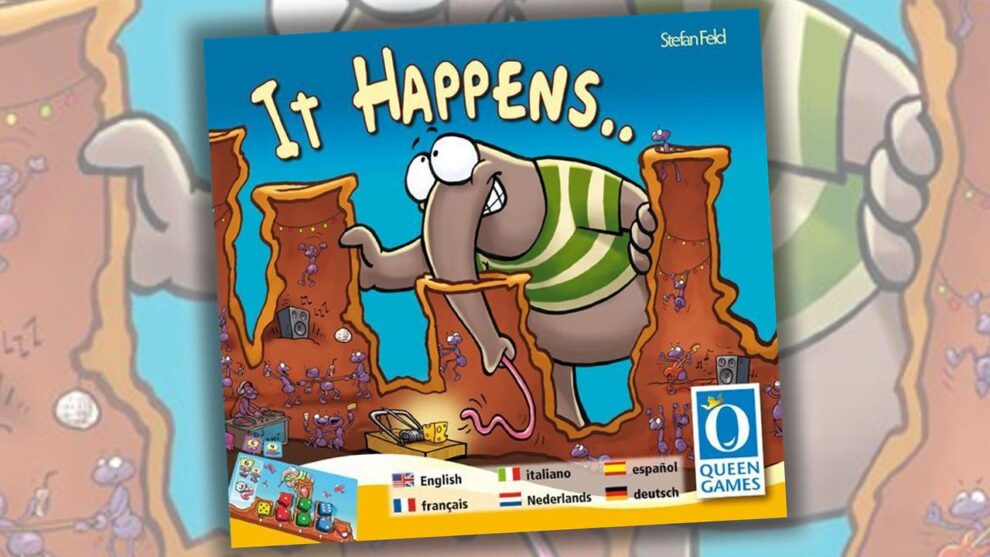Hello and welcome to ‘Focused on Feld’. In my Focused on Feld series of reviews, I am working my way through Stefan Feld’s entire catalogue. Over the years, I have hunted down and collected every title he has ever put out. Needless to say, I’m a fan of his work. I’m such a fan, in fact, that when I noticed there were no active Stefan Feld fan groups on Facebook, I created one of my own.
Today we’re going to talk about 2010’s It Happens.., his 12th game. For the sake of giving autocorrect a break, from this point on, I will be referring to the name of this game without the weird ellipses in the title.
It Happens was Stefan Feld’s fourth game to be published under the Queen Games banner, and it was the last of his games published by them in their small box form factor—the other two being Roma, his first game, and Arena: Roma II, his sixth, which was released just a year earlier. You read that right. Within the span of a single year, from the publication of Arena: Roma II to the publication of It Happens, Stefan Feld had published seven different games.
Here’s another interesting fact: if you thought something along the lines of “This game’s title sounds awfully close to a common phrase containing a dirty word”, you wouldn’t be too far off the mark. Originally, that phrase WAS the game’s title. You can find out more about it, and why the change was made, in this BGG thread.
Overview
In It Happens, players take on the role of a hungry anteater named Anton who is poking his snout into various termite mounds in search of sustenance. Using a dice placement mechanism, the players will influence what Anton is able to collect during his foraging. Some of the collected items can be sacrificed to manipulate the players’ dice.
Dice manipulation is important as, in addition to collecting items, players are competing to place the highest total value of dice in each termite mound location in order to score additional bonus points. Items collected are worth points, both as singularities and as complete sets of items. After four rounds of play, the game ends, final points are tallied, and the player with the most points wins.
Of course, this is just a high-level overview of the game. If you’d like to learn a little more about how the game is actually played, read on. Otherwise, you can skip ahead to the Thoughts section to see what I think of the game.
How It Works
In It Happens, in player order, players will roll one of the dice in their color at the start of their turn and then place that die onto one of three Termite Mound cards. There are a total of twelve of these in the game with three being used in each of the game’s four rounds.
Each Termite Mound consists of five different columns. Each column is divided into a number of spaces that can accommodate one die each. Some of these spaces have illustrations of items on them (gloves, pottery shards, speakers, sneakers, bones, eyeglasses, maps, pharaoh masks, or worms). When a player covers these spaces with one of their dice, they will collect the matching item token from the general supply.
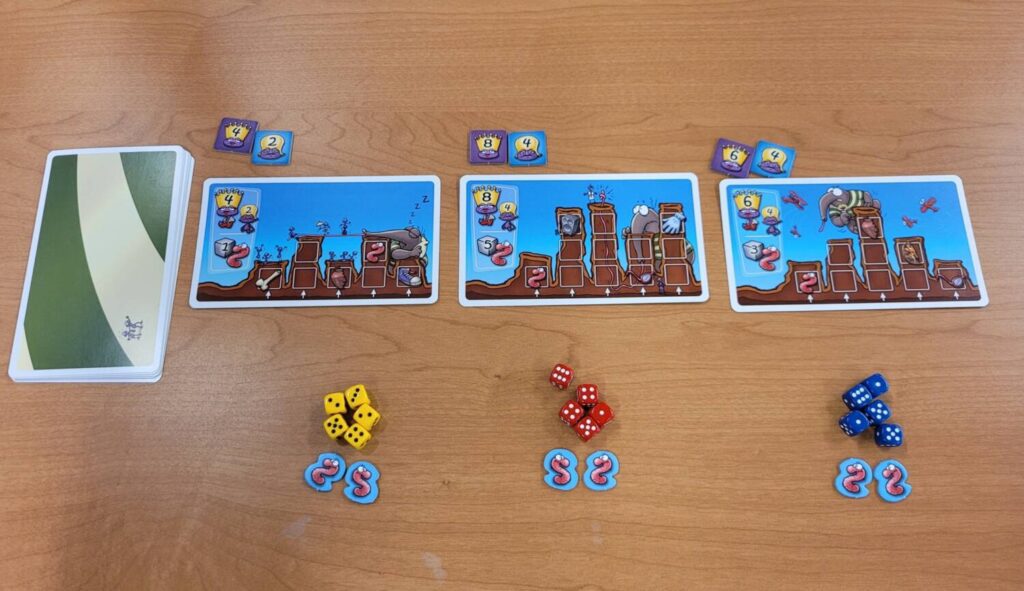
To the left of these columns are displayed a Queen Termite and her General, with specific values assigned to each, as well as a worm with a specified value. These are used during end-of-round scoring.
There are only four rules when placing dice into Termite Mound columns. First, each player may only place their dice into a single column on any given Termite Mound. Second, no player can place their dice into a column in which another player has placed their dice. Third, when placing a die onto a Termite Mound for the first time, you must place your die in the leftmost empty column. Lastly, you can place any die value that you want into your column. You are not required to place in ascending or descending order or anything of that sort.
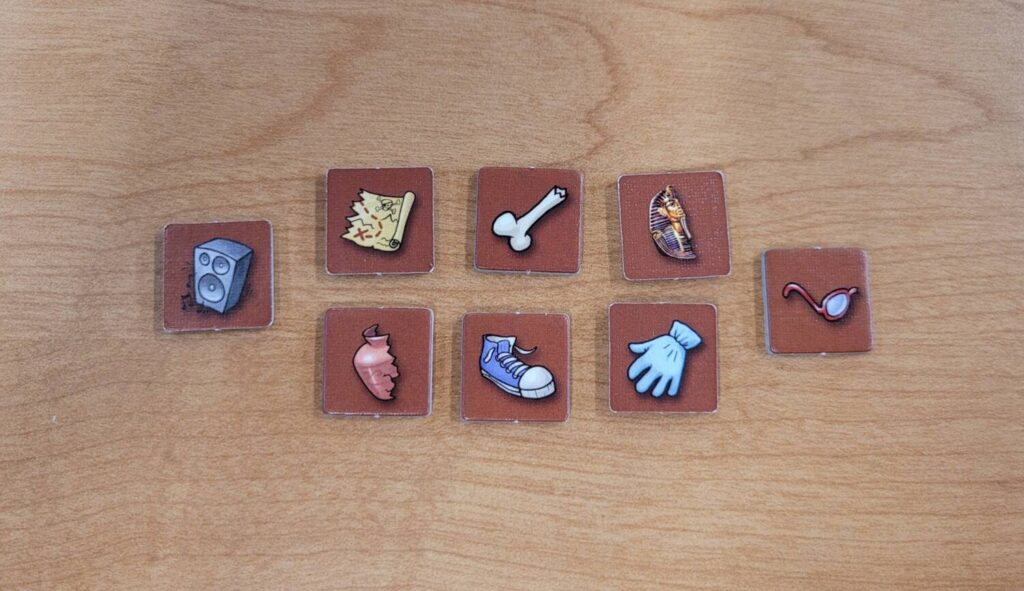
As many times as they want to, and as long as they have any to spare, a player may discard a worm they have collected in order to reroll a die. Worms can also be discarded to allow a player to pass. Otherwise, players keep taking turns until all dice have been placed or no more can legally be placed. Then, each Termite Mound is evaluated to determine who has the highest, and second highest, overall value of dice placed onto the Mound.
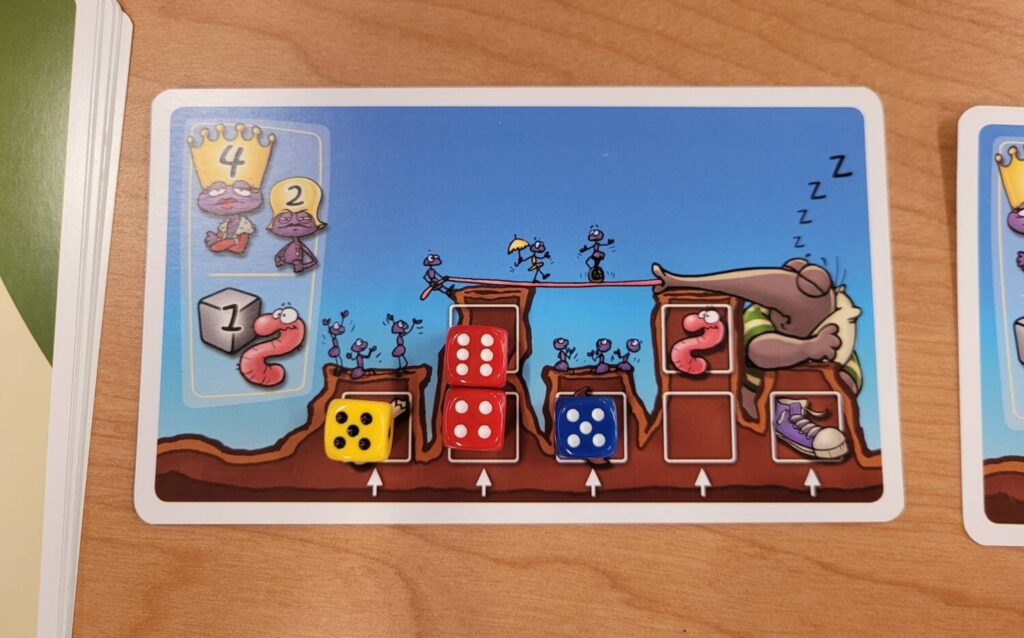
The player with the highest value collects the matching Queen Termite tile from the general supply. The player with the second highest collects the matching General Termite tile from the general supply. Players may also collect a Worm tile if the total on all of their dice adds up to the total shown next to the illustration of the worm.
Scoring
At the end of the fourth round, final scoring is performed.
Players score points based on how many different item types they have collected at least two of. Each Worm tile is worth a point. Points are earned from collected Queen and General Termite tiles. Lastly, players earn an additional ten points if they are among the players who have collected the most different types of tiles.
Thoughts
Ever since I can remember, I have been cursed with the tendency to overthink things. Whereas most people can suspend disbelief and sit back and enjoy a good movie, for example, I simply cannot turn off my brain no matter how hard I try. For instance, I know I am watching a movie about the trials and tribulations of a group of fictional companions trying to deliver The One Ring to the fires of Mount Doom. I know it’s a fantasy movie in a fantastical setting. But, when it is revealed that one of them has the ability to summon winged allies that are capable of carrying a human being on their back, it begs the question: why didn’t they just do that from the start? It would have saved a ton of time and grief. And, having thought about that, I can’t stop thinking about it, and the movie is completely ruined for me.
I mention this because, it is with that over analytical approach to things that I find certain aspects of It Happens to be absolutely infuriating. Here’s a small list:
– Who am I? Am I Anton? Why am I being controlled by 2 to four people? Why are we controlling a singular entity as opposed to competing anteaters? Does Anton have multiple personalities? Or am I really controlling the termites? What in the actual hell is even going on?
– Why aren’t there actual termites for me to catch? Why am I awarded with the Queen/General when all I’ve managed to find is garbage? Are the termites so busy trying to fob their trash off on me that they forgot to protect the most important member of their entire colony?
– Some of these items the termites are tricking me into gathering are massive. Just how big is Anton? And how big do the termites have to be to carry a solid gold pharaoh’s mask on their backs? And how massive must the termite mounds be in order to be able to dispense stereo speakers?
The more I think about the theme, the more my brain hurts. To say that the theme is not well-integrated would be an understatement. From a thematic standpoint, this game makes zero sense. But I do love Michael Menzel’s artwork here. It’s lighthearted and fun, and I suppose that’s how I’m meant to approach the game. So, here we go.
Take a deep breath, David. Accept the fact that nothing makes sense. Focus on the game play. Ignore the rest. Just relax.
Okay.
Now that I’ve found my zen place, I’m pleased to tell you that, despite everything I’ve said before, It Happens (and, oh my, what were they even thinking with that title?!) is actually a pretty decent little game – its pros far outweighing its cons.
For starters, it’s small both in, and out of, the box. This is a game that easily fits into a backpack and can be set up in seconds. Once you’ve got it set up and are actually playing it, it doesn’t take up much room at all. Secondly, it’s short. From setup, to teach, to finish, to teardown, you’re talking about maybe 40 minutes. It’s the perfect lunchtime game, which is when I primarily play it.
This next pro could also be seen as a con. From a pure gameplay standpoint, It Happens is, hands down, Stefan Feld’s lightest game. Its lightness makes it suitable for a wide range of players of different skill levels. However, that lightness is a double-edged sword. If you’re into heavier fare, unless you’re a die hard Feld fanatic or have an extremely limited selection of games at your disposal, it’s doubtful that It Happens is going to be removed from your shelf very often. As far as games go, it isn’t a very challenging one. The decisions you need to make are pretty straightforward and there are never any moments where anything surprising is thrown at you. Considered by itself, it’s fine. But, when placed up against other, more interesting games of similar lengths, you’ll find it lacking.
While that may be true, there are still plenty of interesting things to think about. Placing your dice in It Happens is all about timing. Recall that, other than being considered for majority ownership, items collected during the game aren’t worth anything by themselves unless you’ve managed to collect a pair of them. This creates competition for those columns that feature items, especially when one of those items is the second in a pair that you or someone else already has the other half.
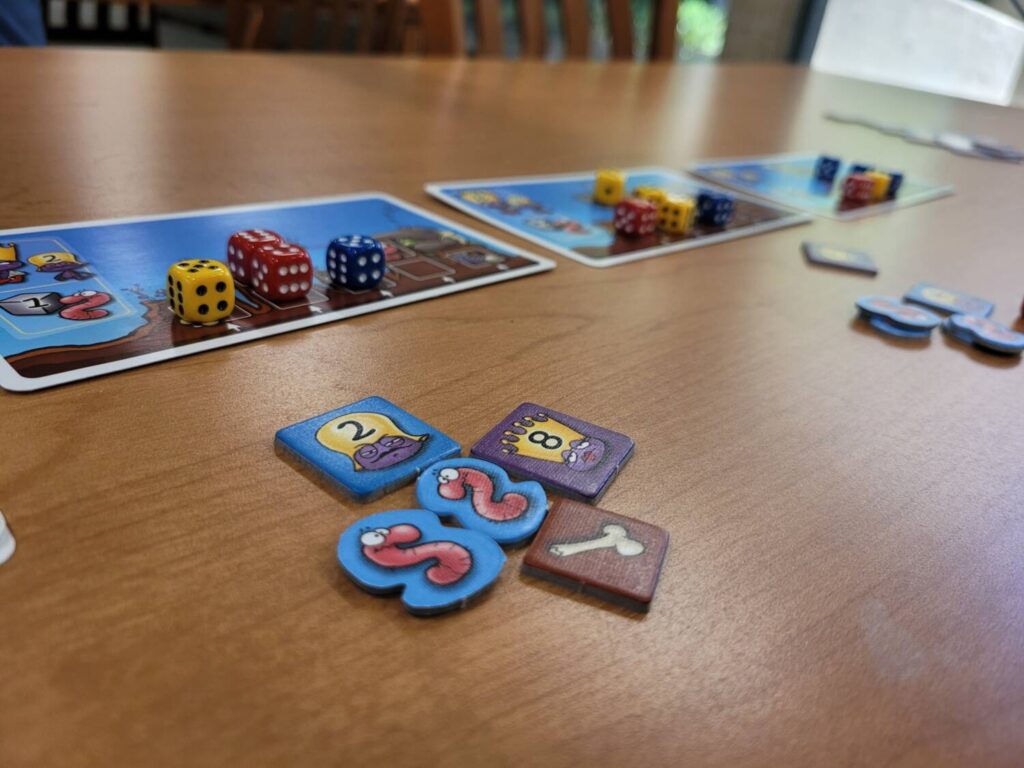
Everyone wants that item, but nobody wants to help anyone else get there. Eventually, though, someone is going to have to place a die onto that Termite Mound, and that’s going to open the floodgates. So, do you bite the bullet, forgo the item, and focus on winning the Queen termite? Or, do you try to manipulate the other Termite Mounds to force someone else to bite that bullet so that you can swoop in and capitalize? Or, maybe the better move would be to simply cash in a worm, giving up a point, to bow out for the rest of the round to ensure that nobody gets that item. These decisions become especially interesting in a two-player game where the players are also placing two dice for the same dummy player, in addition to their own contingent of dice.
Despite its lightness, there’s still plenty here to make things interesting.
So, if you’re wanting to stick your snout into a termite mound full of point salady goodness, you’re not going to find that here. But, if you’re in the market for a lighthearted Feld-driven romp that the entire family can play, then It Happens just might be the game for you.


